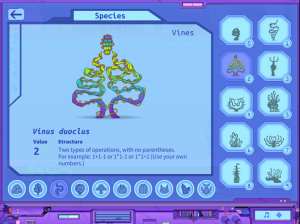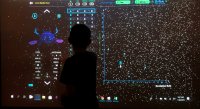Game-Based Learning in Middle School Math
Working with teachers, researchers created free online math games that encourage students to persist in grappling with difficult concepts.
Your content has been saved!
Go to My Saved Content.Teachers all over the country are coming up with different solutions to the problem of motivating students to persist with math learning. One potential solution that excites a lot of teachers—and their students—is game-based learning, and I recently had a chance to get an inside look at how games can be used in math education by talking to the creators of a free online platform called Math Snacks.
Funded by the National Science Foundation, Math Snacks is a set of games and animations for middle school students that has brought math educators and learning theory researchers together with multimedia developers in a fruitful collaboration.
I sat down with Barbara Chamberlin, director of the Learning Games Lab at New Mexico State University, and Ted Stanford, associate professor in the Department of Mathematical Sciences at New Mexico State, to discuss Math Snacks and effective strategies for integrating multimedia in the classroom. Our conversation has been edited for length and clarity.
AMANDA ARMSTRONG: Let’s jump right in: How did Math Snacks come into being?
BARBARA CHAMBERLIN: It happened many years ago when we were talking about some of the gaps we kept seeing with middle school math learners. In the Learning Games Lab, with our background in game development and animations, we were starting to say we could narrow in on those gaps and counter some of those in exciting and interesting ways.
We asked, “What are the things kids often struggle with?” As we drilled down on that, we found that these concepts usually were concepts they didn’t fully understand in grades 2 and 3 but were emerging now that those kids were in middle school and were dealing with fractions and decimals.
TED STANFORD: There are several big ideas that sort of hit all at once in middle school, like ratio, rate, and scale factor, in particular. The big issue is, there are these key ideas and you can put an image to them. We used to talk a lot about concept image, your idea of what a rate is. It isn’t just a calculation, it’s an idea, it fits into a story, it has a picture associated with it, and maybe a need—why do you need to do this?
ARMSTRONG: You wanted the games to relate to a real-world application?
CHAMBERLIN: Yes. With games like Agrinautica and Curse Reverse, for example, we hope students become very comfortable with variables. Our goal was not to get students to learn how to solve expressions—our goal was to help them think through solving problems in logical ways. Our goal with these games was to help students look at algebra as a really logical way to address those problems. We’re not teaching students algebra—we’re teaching the concepts that help them deal with problem-solving, and notation, and written algebra.

STANFORD: I hope what Curse Reverse does is, when you’re done with that game, you’ll feel like using algebraic notation, using variables, and it makes sense in this context. Then when you get in my algebra class, you can take a deep breath and say, “OK, I know that this tool is a logical tool that makes sense and is useful for some things.” You might feel more comfortable that this is a sensible way to approach the world.
ARMSTRONG: So the games are engaging for students?
STANFORD: A game can draw somebody in—the same ideas may be laid out on a piece of paper or in a textbook, but they don’t draw you in in the same way. You get instant feedback from a game. The game responds very quickly to what you do, and it’s private. You don’t get judged by it. There is this idea that you can try things. You can fail, and you instantly find out what happens. Then you try again, and it’s not discouraging. It can challenge kids.
ARMSTRONG: What was the role of teachers in your design process? How were they involved in the creation of Math Snacks?
CHAMBERLIN: A lot of people on our team have been classroom teachers, which was critically important and very helpful. Even those who haven’t been classroom teachers do a lot of classroom instruction in this age group.
We would take prototypes to teachers and have them play with the prototypes. We would watch how they would deal with it and talk with it. We brought teachers and kids in over the summer and asked teachers to come up with a workshop around this kind of game prototype and teach it to the kids. Teachers would work together to come up with something and teach the session. The kids would go home, and the teachers would talk to each other about what they observed, what should be changed, what worked, and what didn’t. The teachers would reorient their lesson plans and then the next day would bring in new kids, and then teach the lesson again with their changes.
We got to watch the teachers iterate on lesson plans. We got to see them teach with the game, change their lesson plan and activity again, do it again, change it a little bit, do it again.
STANFORD: The social interaction, the social learning, that was a big surprise because one point of view about game development is you want a kid to be able to go off in their room and play this game for two hours and learn something. And that’s good. That happens, and that’s not a bad thing to shoot for.
But there is so much more that a game can be. Two kids playing together is so cool—there are all these things that happen when kids play a game together that don’t happen when they play alone. The technology isn’t just a thing that one person does with a computer—it drives all this other learning that’s based on interactions between people.
